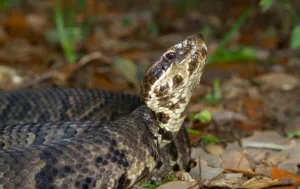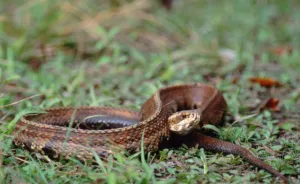
Table of Contents
Scientific Classification
- Kingdom: Animalia
- Phylum: Chordata
- Class: Reptilia
- Order: Squamata
- Suborder: Serpentes
- Family: Viperidae
- Genus: Agkistrodon
- Species: A. piscivorus
Quick Overview
The Water Moccasin, scientifically known as Agkistrodon piscivorus, is a venomous pit viper commonly found in the southeastern United States. Also known as the Cottonmouth, this snake is known for its semi-aquatic habits, distinctive appearance, and potent venom. Recognizable by its threatening display and habitat near water bodies, the Water Moccasin is a significant species in the southeastern ecosystems.
Fast Facts
- Scientific Name: Agkistrodon piscivorus
- Lifespan: Typically around 10 to 15 years in the wild
- Average Length: 2 to 4 feet, with some individuals reaching up to 5 feet
- Diet: Carnivorous, feeding on fish, amphibians, small mammals, and birds
- Habitat: Swamps, marshes, slow-moving streams, and other aquatic environments
Did you know?
Water Moccasins are called “Cottonmouths” due to the white, cotton-like interior of their mouths, which they expose as a warning when feeling threatened.
Appearance
Water Moccasins have a robust body with dark coloring, often appearing black or dark brown. They have distinct bands across their bodies, providing excellent camouflage in their preferred aquatic habitats. Juveniles may have vibrant patterns that fade with age, and their eyes have vertical pupils.
Size and Weight
Adult Water Moccasins typically measure between 2 to 4 feet, with females generally being larger than males. The weight varies, with individuals ranging from 1 to 5 pounds.
Temperament and Behavior
Water Moccasins are generally territorial and can be aggressive when cornered or threatened. They are excellent swimmers, often floating on the water’s surface with their heads raised. Despite their intimidating reputation, they may choose to flee rather than confront potential threats.
Fun Fact
Water Moccasins can accurately strike both in and out of the water, making them formidable hunters and defenders.
Habitat and Distribution
These snakes prefer habitats near water, including swamps, marshes, and slow-moving streams. Their range extends across the southeastern United States, from Virginia to Florida and west to Texas.
Care Guide
Water Moccasins are not suitable as pets due to their venomous nature and specific habitat requirements. In their natural habitat, they play a crucial role in controlling aquatic prey populations.
Diet and Nutrition
As the name suggests, Water Moccasins primarily feed on fish. They also consume amphibians, small mammals, and birds. Their venom aids in subduing prey, allowing them to consume their meals.

Health and Wellness
Encountering a Water Moccasin in the wild should be approached with caution, as their venom, while rarely fatal to humans, can cause pain and swelling. Seeking immediate medical attention is essential if bitten.
Reproduction
Water Moccasins give birth to live young, with the number of offspring varying. The gestation period lasts around five months, and the young are independent upon birth.
Conservation Status
Water Moccasins are not currently classified as endangered, and their populations are generally stable. Conservation efforts focus on preserving their natural habitats.
Photo Gallery




Related Profiles
Share This Profile
3 Fascinating Facts About Water Moccasin
- Ecosystem contributors: Despite their venomous nature, Water Moccasins are vital to the ecosystem, contributing to the balance of aquatic prey populations.
- Aquatic Ambush: Proficient swimmers, Water Moccasins use the water as a means of ambushing prey, showcasing their adaptability in aquatic environments.
- Venomous Defense: Water Moccasins possess venom to subdue prey and defend themselves, but their role in controlling aquatic ecosystems is essential for maintaining balance.
- Enchi Ball Python: A Unique and Stunning Morph of Python regius - March 27, 2025
- Emerald Tree Monitor: The Enigmatic Green Guardian of the Rainforest - March 26, 2025
- The Egyptian Cobra (Naja haje): A Fascinating Serpent - March 25, 2025
